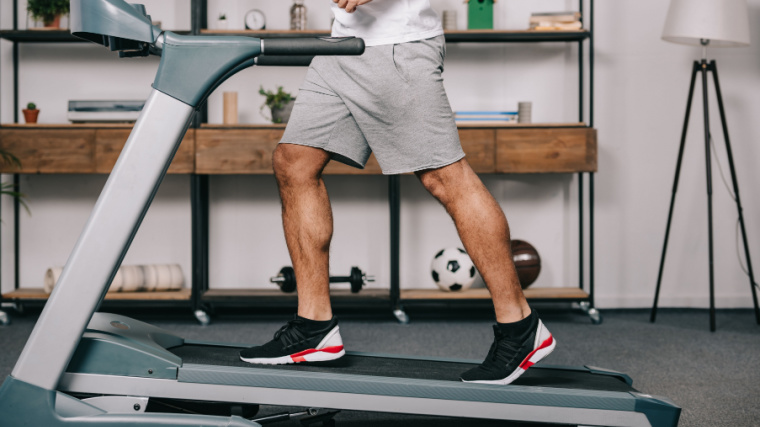Let’s face it: The treadmill (unfairly) gets a bad rap. Merely mentioning it as a cardio option can quickly cause your training partner’s enthusiasm to evaporate. After all, many people associate treadmill workouts with unflattering terms like boring, monotonous, and uninspiring.
Yet even if your previous treadmill experiences failed to elicit motivation or effective results, it’s not too late to change your tune. Whether you’re focused on losing fat, improving your metabolic conditioning, or recovering efficiently, this popular piece of home gym equipment can help put you on a path to success.

Plus, you don’t have to invest what can seem like countless hours and steps to make physique, performance, or health improvements. Here are three goal-specific workouts that only take 30 minutes to complete and have the potential to transform your opinion about treadmills.
30-Minute Treadmill Workouts
30-Minute Treadmill Workout for Fat Loss
While nutrition plays a major role in your ability to lose body fat, exercise can enhance your efforts to trim extra inches off your waistline. (1) However, if you have a limited window to hit the gym, it’s important to get the most bang for your fat-burning buck. When it comes to your next treadmill session, swap out the slow, steady-state approach for something that’s proven to be more efficient and effective: high-intensity interval training. (2)
Sprint Intervals
This type of workout isn’t for the faint of heart. Ultimately, though, sprint intervals provide a unique stimulus that simply can’t be replicated with steady-state cardio training. Combining brief periods (less than one minute) of high-intensity runs with a far less demanding walking interval of equal time will push you mentally and physically.
Most importantly, however, this method provides more fat-burning upside than simply going at the same speed throughout your workout. In fact, a study comparing calories burned during 30 minutes of HIIT, weight training, running, and biking showed that HIIT participants burned 25-30 percent more calories. (3)
Considering you need to be in a calorie deficit to lose body fat, following a well-structured eating plan that prioritizes protein and engaging in strength training and HIIT-style cardio can be quite a powerful fat-loss solution. (4)

Keep in mind that you can make this workout more demanding in a number of different ways. Setting the treadmill on a low incline will put more stress on your quads and your glutes. As you improve, you can reduce the rest time between sets, which could give you room to fit a few more rounds within that 30-minute window.
Because this workout is ultra-demanding on just about every part of your lower body, it’s best to save it for a non-leg day. Additionally, while you can pencil it into your schedule two to three times per week, make sure to do so on non-consecutive days so you’re able to recover and hit the gym again.
Treadmill Interval
- How to Do it: Set the treadmill to a flat position. Gradually build up speed until you reach a jogging pace. At the two-minute mark, increase the speed to a level in which you can safely maintain a sprint for the desired time. After you’ve hit your target time for the first part of the interval, decrease the speed and maintain a slow pace for an equal amount of time.
- Sets and Reps: Five sets of 30 seconds at a sprint pace, followed by 30 seconds at a slow pace (casual walk). Repeat twice. Then, complete two sets of 45 seconds at a fast pace, followed by 45 seconds at a slow walking pace. Repeat once.
- Rest Time: Rest two minutes between intervals.
30-Minute Treadmill Workout for Conditioning
Metabolic conditioning may lead to fat loss, but that’s not the sole objective. Rather, this exercise methodology is all-encompassing in its mission to improve both your endurance and strength. Increasing your work capacity can allow you to shine brighter in your weightlifting sessions or give you the cardiovascular foundation to maintain an elevated heart rate for a longer period.
Incline Intervals
The treadmill presents a prime opportunity to get in better overall shape if you take advantage of the incline feature. Unlike the fat-loss workout, though, you don’t have to go top speed to get closer to your end goal.
That said, interval-style training reigns supreme when it comes to conditioning. You can take things to the next level (literally) through incline treadmill training, which has been shown to be effective for improving oxygen consumption, blood lactate responses, and muscle power. (5)

This 30-minute treadmill workout revolves around manipulating the incline and the speed in a pyramid-style fashion. Once you navigate through that portion, you’ll get a chance to finish on a high note with a run that’ll force you to push through every last step.
Treadmill Incline Intervals
- How to Do it: Begin with a three-minute warm-up at a comfortable walking speed with the incline at 3%. Every two minutes, increase the incline by 2% and the speed by 0.5 until you reach 15 minutes. Then, reduce the speed by 0.5 and the incline by 1% every two minutes until the 23-minute mark. At that point, ramp up the speed, set the incline between 3 to 5% and finish with a higher intensity run, followed by a brief cooldown interval.
- Sets and Reps: 10 “sets” of two-minute incline intervals, one five-minute running interval, and a two-minute cool-down period. 30 minutes total training time.
- Rest Time: No rest time between intervals.
30-Minute Treadmill Workout for Recovery
Not every treadmill program has to be interval-based. In fact, a no-frills, steady-state-style session is a great way to recuperate from a muscle-building workout. If you want to get your body primed to train again, a treadmill-centric approach is simple, yet effective.
Steady State and Stretch
When it comes to recovery, staying stationary won’t yield the best results. On the contrary, movement is key to reducing lactic acid buildup, eliminating toxins, and shuttling nutrients into your cells. (6)
A positive correlation between increased blood flow and performance recovery makes low-impact forms of aerobic exercise a logical choice. (7) While that doesn’t mean you should fully eliminate rest days, it does mean you should incorporate active recovery into your weekly routine. Cycling and swimming fit the bill, as does a steady-state treadmill workout.
You don’t need to overcomplicate it, either. Depending on how much time you have, you can pair a timed walk with a series of mobility exercises to enhance your recovery.
Treadmill Walk and Mobility
- How to Do it: Start with the treadmill on a flat position, or very low incline (from 1 to 3%). Set the speed to a brisk walking pace you can comfortably maintain for 20 to 25 minutes. Then, complete each of the exercises outlined in the “warm-up” sequence below.
- Sets and Reps: One “set” of a 20 to 25-minute walk, followed by 5 to 10 minutes of mobility work. 30 minutes total training time.
- Rest Time: No rest time.
How to Warm-Up for a 30-Minute Treadmill Workout
When you’re about to spend 30 minutes on a treadmill, it might be easy to think you don’t need to warm-up. However, that’s certainly not the case — especially if you want to fully reap the rewards of your upcoming cardio session.
Completing a structured warm-up protocol not only offers injury prevention and performance benefits, but it also gives you a chance to prepare your mind for the challenges ahead. (8) And considering you’ll have to repeatedly ramp up the intensity to optimize fat burning, you’ll need to prime your joints, muscles, and tendons before you dive into your workout.
This four-part warm-up routine addresses key areas like the hamstrings, hips, and glutes — all of which will be put to the test once you step foot on the treadmill.
30-Minute Treadmill Workout Warm-Up
- Forward Leg Swing: Stand straight with your feet about hip-width apart. While keeping one leg stationary, carefully swing the opposite leg forward and backward in a controlled movement, progressing from small swings to larger ones. Complete two sets of 10-15 repetitions per leg before moving to the next exercise.
- Hip Circle: Stand with your feet shoulder-width apart and your hands on your hips. As you shift your weight to one foot, maintain an upright posture and slowly rotate your hip in a clockwise direction as if you were drawing a circle. Complete 10 repetitions, then go counterclockwise for another set of 10. Perform twice on each leg.
- Lateral Lunge: With your feet hip-width apart, take a lateral step with your left leg. Push your hips back and bend your left knee until it reaches 90-degrees. Drive off of your left foot and return to the starting position. Perform 10 repetitions, then switch sides. Repeat before finishing with the final exercise.
- Kang Squat: Stand up straight with your feet between hip- and shoulder-distance apart and your toes pointed slightly out. Place your hands behind your head, brace your core, and hinge forward at your hips. Then, lower your torso until it is almost parallel with the floor. Sit your hips back and bend at the knees until you reach a full-depth squat. Push through your heels and perform the opposite motion to return to a standing position. Complete one set of 10-12 reps.
Don’t Underestimate the Power of a Half-Hour
Any 30-minute workout can be effective — as long as you put in the effort. Although treadmill training alone won’t necessarily give you your ideal physique, it can be strategically incorporated into your overall fitness routine as a way to drop body fat, get in better condition, or aid in recovery. Commit a half-hour to this misunderstood machine and you may be surprised at how much you enjoy every minute of whatever workout you choose.
References
- Kolnes, K. J., Petersen, M., Lien-Iversen, T., Højlund, K., & Jensen, J. (2021). Effect of Exercise training on Fat Loss—Energetic perspectives and the role of improved adipose tissue function and body fat distribution. Frontiers in Physiology, 12. https://doi.org/10.3389/fphys.2021.737709
- Viana, R. B., Naves, J. P. A., Coswig, V. S., De Lira, C. a. B., Steele, J., Fisher, J., & Gentil, P. (2019). Is interval training the magic bullet for fat loss? A systematic review and meta-analysis comparing moderate-intensity continuous training with high-intensity interval training (HIIT). British Journal of Sports Medicine, 53(10), 655–664. https://doi.org/10.1136/bjsports-2018-099928
- Falcone, P. H., Tai, C., Carson, L. R., Joy, J. M., Mosman, M. M., McCann, T. R., Crona, K. P., Kim, M. P., & Moon, J. R. (2015). Caloric expenditure of Aerobic, Resistance, or Combined High-Intensity interval training using a hydraulic resistance system in healthy men. Journal of Strength and Conditioning Research, 29(3), 779–785. https://doi.org/10.1519/jsc.0000000000000661
- Strasser, B., Spreitzer, A., & Haber, P. (2007). Fat loss depends on energy deficit only, independently of the method for weight loss. Annals of Nutrition and Metabolism, 51(5), 428–432. https://doi.org/10.1159/000111162
- Ferley, D. D., Osborn, R., & Vukovich, M. D. (2014). The effects of incline and Level-Grade High-Intensity Interval treadmill training on running economy and muscle power in Well-Trained Distance runners. Journal of Strength and Conditioning Research, 28(5), 1298–1309. https://doi.org/10.1519/jsc.0000000000000274
- Draper, N. (2006, March 1). Effects of active recovery on lactate concentration, heart rate and RPE in climbing. PubMed Central (PMC). https://www.ncbi.nlm.nih.gov/pmc/articles/PMC3818679
- Borne, R. F., Hausswirth, C., & Bieuzen, F. (2017). Relationship between blood flow and performance recovery: a Randomized, Placebo-Controlled study. International Journal of Sports Physiology and Performance, 12(2), 152–160. https://doi.org/10.1123/ijspp.2015-0779
- Fradkin, A., Zazryn, T. R., & Smoliga, J. M. (2010). Effects of warming-up on Physical performance: A Systematic review with meta-analysis. Journal of Strength and Conditioning Research, 24(1), 140–148. https://doi.org/10.1519/jsc.0b013e3181c643a0
Featured Image: Artem Bestsenny / Shutterstock
Trending Products

FITINDEX Vibrating Foam Roller 5 Speed, Next Generation Portable 11.4×4.7“ Electric Foam Roller for Muscle Relax, Fitness Deep Massage Rechargeable Foam Roller for Yoga Exercise Post Workout, Gray

Resistance Bands for Working Out with Workout Bands Guide. 4 Booty Bands for Women Men Fabric Elastic Bands for Exercise Bands for Legs for Working Out Hip Thigh Glute Bands Set

GAODI Women Waist Trainer Vest Slim Corset Neoprene Sauna Tank Top Zipper Workout Body Shaper Shirt (L, Black Sauna Vest)

FITNE Green Tea Herbal Honey Lemon With Garcinia Senna Infusion Gentle Detox Cleanse High Antioxidant No Calories Stevia Sweetener, 15 Tea Bags

Sunny Health & Fitness Squat Assist Row-N-Ride™ Trainer for Glutes Workout with Online Training Video

FITNE Black Currant Herbal Green Tea Fruity Garcinia Senna Infusion Gentle Detox Cleansing Boost Antioxidant Wellness Tea No Calories, 15 Tea Bags








